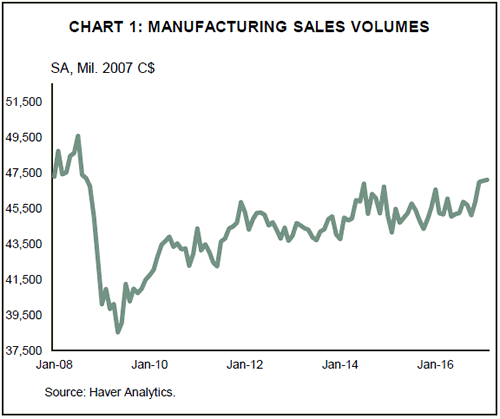HIGHLIGHTS OF THE WEEK
United States
- Economic data this week remained consistent with the theme of an economy nearing full employment.
- Headlines were dominated this week by rising tensions with North Korea and the increased odds that the French Presidential elections could result in the victory of an anti-EU candidate.
- Comments from President Trump’s interview with the Wall St. Journal imply that tax reform is now secondary in importance to health care reform. Less scope for fiscal stimulus may imply a more gradual process of monetary policy normalization than previously anticipated.
Canada
- Manufacturing sales beat expectations in February, with volumes rising 0.1% to the highest level since September 2008.
- Housing starts surged to over 250k units (annualized) in March, marking the fastest pace of building activity in nearly a decade.
- The Bank of Canada left the overnight rate unchanged at 0.50% and upgraded its growth outlook for this year to 2.6% (previously 2.1%). Notwithstanding the upward revision to the numbers, its language emphasized downside risks and caution on the outlook for the Canadian economy.

UNITED STATES – REFLATION TRADE FIZZLES AS GEOPOLITICAL RISKS RISE
There was little in terms of data this holiday week to move financial markets. February data from the job opening and labor turnover survey (JOLTS) showed an uptick in job openings, a downtick in new hires, and a reversal of previous month’s strength in the separations rate. Similarly, initial claims data for last week held near historic lows, further corroborating the theme of a healthy labor market. The key message permeating the data is that the job market is nearing full employment, yet more reason to look past last week’s disappointing payrolls number.
In addition to the labor market data, updates on small business sentiment and producer prices were released. The NFIB’s optimism index cooled for the second consecutive month, but small business remains highly optimistic by historical standards. Growth in core producer prices meanwhile, remains consistent with gradually rising price pressures. Although producer prices in March fell on a month-on-month (m/m) basis, the move was largely driven by energy prices, leaving prices for the final demand goods excluding food and energy category rising by a firm 0.4% m/m.
Overall, there was little change in economic fundamentals this week to motivate the shifts in financial markets, which were drowned out by geopolitical developments and apparent shifts in domestic policy.
News out of North Korea dominated headlines early this week, with fears of an imminent confrontation between the U.S. and the pariah state contributing to a selloff in risk assets and a strong bid on safe havens such as Treasuries and gold. There was initially hope that the meeting between the Presidents of China and the U.S. last week would reduce tensions, but the subsequent bolstering of America’s military presence in the Korean peninsula has resulted in the opposite.
Markets also became concerned with the French Presidential election, which has seen a surge in another populist, anti-EU candidate in polls for the first round of elections set to take place in ten days. Jean-Luc Mélenchon, a far-left socialist candidate, is nipping at the heels of third placed Francois Fillon, and his momentous rise in the polls has raised the odds of a presidential runoff election in early May between two anti-EU candidates.
On this side of the Atlantic, President Trump’s comments in an interview with the Wall St. Journal suggest a shift toward more conventional policy. For one, President Trump advocated for the need to accomplish healthcare reform before tax reform. President Trump also backed off on plans to label China a currency manipulator, and expressed concern that the strong U.S. dollar has been hurting American exporters. He also reversed his view of the Export-Import bank, suggesting that it was "… a very good thing. And it actually makes money, it could make a lot of money". Lastly, he appeared to soften his stance on the Federal Reserve’s policy of low interest rates.
These statements altogether suggest that stimulus from tax cuts is less likely in the near term. Less scope for fiscal stimulus may imply a more gradual process of monetary policy normalization than previously anticipated. Add into the mix elevated geopolitical uncertainty and it looks more and more like the reflation trade’s days are numbered.


CANADA – CENTRAL BANK STILL CAUTIOUS ON OUTLOOK
There were two Canadian data releases and a Bank of Canada announcement this week, which, combined with rising oil prices and remarks from Trump that the USD is too high, sent the loonie up to a 6-week high of 75½ US cents.
Both of the key data releases continued the trend of better-than-expected activity at the start of this year. Manufacturing sales beat expectations, with volumes rising by 0.1% in February. This marks the 4th consecutive increase and brings volumes to the highest level since 2008. Forward looking indicators suggest that this momentum could continue going forward. Combined with a strong hand off from the end of 2016, manufacturing output is on track to add favourably to growth during the first quarter of the year.
Ditto for residential construction. Housing starts surged to over 250k units (annualized) in March – the fastest pace of building activity in nearly a decade. For the quarter as a whole, construction was up by a whopping 15% q/q. This pace of building is unlikely to be sustained, however, with some payback likely in store in the coming months. Still, overall economic growth for the first quarter is set to come in quite strong, tracking a robust 3.4% annualized.
Perhaps the highlight of the week was Wednesday’s Bank of Canada announcement and accompanying Monetary Policy Report. The remarkable performance of the Canadian economy in recent months, combined with the Federal Reserve in tightening mode stateside, had prompted some expectations for a more hawkish tone from the Bank of Canada. However, despite an improved outlook, Canada’s central bank remains quite cautious.
As expected, the overnight rate was left unchanged at 0.50%. However, growth forecasts were indeed upgraded for this year, with the Bank now forecasting economic activity to advance by 2.6% (previously 2.1%). Accordingly, it also expects the output gap to close in the first half of 2018 – slightly earlier than the mid-2018 expected previously.
Despite these improvements, the Bank is clearly not convinced that the Canadian economy is out of the woods just yet. The communique struck a somber tone, noting that ‘material slack’ still exists in the economy, that soft spots remain – notably, hours worked, uneven export growth and challenges related to business investment – and that it is simply too early to declare the economy on a sustainable growth path. What’s more, the Bank’s growth profile suggests that it views the near term growth drivers – consumer spending and residential investment – as transitory and likely to slow in the coming quarters, while it awaits a more consistent improvement from exports and business investment. The cautious approach also reflects risks to the outlook, particularly those outside Canada’s borders such as the implications from any new policy actions south of the border.
All told, the Bank has clearly not forgotten that the Canadian economy has endured a couple of false starts in recent years. While some pullback from the exceptionally strong start to the year is likely, we expect economic activity to chug along at a healthy clip of around 2% over the remainder of this year. This is unlikely to be enough to entice the Bank of Canada to pull the trigger on higher rates; however, it will allow economic slack to be absorbed and should pave the way for a rate hiking cycle to begin in 2018.













